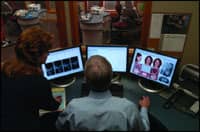by David Way, DDS, MS, and Marla Kindsfater
Digital technology is essential to the one-appointment exam/consultation

Many outside factors have had a profound effect on orthodontic office procedures in the last decade. Occupational Safety and Health Administration (OSHA), Americans with Disabilities Act (ADA), and Health Insurance Portability and Accountability Act of 1996 (HIPAA) regulations have changed many of the normal routines in our offices. In addition, the average orthodontic practice is larger than it was 15 years ago. Therefore, computer technology has not only been an aid but has become essential for efficient, quality care and organization of all patient information.
In particular, many forward-thinking practitioners have condensed their examination and consultation appointments from two or three office visits into a single—but very organized and thorough—appointment.
Technology and Today’s Society
 |
 |
Contemporary adolescent patients have been immersed in technology and can be described as the “No Fear” generation when it comes to technology. Affluent and less-affluent families alike are exposed to all forms of digital technology every day. Because we live in a visual world of multimedia advertising and have instant access to information via the Internet, our entire patient population has raised its expectations, whether we are aware of this or not. We can either embrace this very useful technology or risk being viewed as technologically challenged. Technology should be viewed as just another tool to better educate and inform our patients, as well as to provide the practitioner with essential diagnostic information in a very efficient manner.
The demographics of families in the United States have also changed significantly during the past 20 years. According to the 2002 statistics from the US Department of Labor, single-parent families with children under 18 years of age compose 20% of the nation’s workforce. The vast majority of these families are headed by females working full time. By 2006, women will represent 47% of the US labor force. The percentage of families in which both parents work full-time has grown to an overwhelming majority. This, coupled with a significant increase in the participation of schoolchildren in multiple extracurricular activities, has placed severe time constraints on the families in our patient base.
With the advent of the newer “high-tech” wires, many orthodontic practitioners are appropriately replacing the traditional 4-week appointment interval with a 6-week to 8-week interval. The reaction to lengthening appointment intervals has been overwhelmingly positive once the parents understand that this is an appropriate interval based on the physiology of tooth movement that can be created by lower-force memory wires. It also helps that there is less discomfort and less intrusion on the patient’s already busy schedule.
Requiring prospective parents and patients to visit an office three times before accepting treatment may become a negative influence in their selection of an orthodontic practice. More importantly, we feel very strongly that the education process can be much more effective in a one-step process that helps keep the patient and parent focused. The advantage to the orthodontist is that he or she maintains a continuous and organized thought process and does not have to “refamiliarize” himself or herself with the intricacies of each individual patient’s case two or three times prior to the commencement of treatment.
Orthodontists implementing a one-appointment examination/consultation need not compromise in quality. In fact, a well-defined, detailed, comprehensive examination can yield excellent results by guiding the practitioner to the appropriate treatment options for each individual patient. Proper integration of software and hardware technology is the key to gathering all of the diagnostic data necessary for a comprehensive one-step examination/consultation. Recording of the patient’s expectations, treatment goals, and health history can be obtained with a tablet PC, which integrates with the patient’s digital records. Digital photographs, digital radiographs, and cephalometric evaluations can be obtained quickly and efficiently using digital technology. Patient-imaging, patient-education, and practice-management software must all work in concert. Ideally, the software should compile all of the components of a multimedia educational presentation automatically, based on the patient’s examination findings.
The examination and treatment recommendation letter, complete with copies of the photographs and radiographs, are generated and presented “instantaneously.” We must remember that technology is an efficient tool that can help organize our thought process, leading to a complete and thorough diagnostic examination. As practitioners, our experience and clinical expertise will help determine the appropriate treatment choices.
In this article, we will propose our concept of an organized examination and information-gathering process, and we will show how the presentation and education process can be aided by the utilization of digital technology and integrated software. After reading this article, you may find that it may become necessary to make changes to your current office design to better facilitate patient care.
Exam/Consultation Procedure
The steps taken by the orthodontist and staff can be outlined as follows:
1) After the initial phone call, office information, patient questionnaires, and health histories are mailed out—or preferably, the patient or parent is directed to the practice’s Web site to download or complete the HIPAA-compliant forms online.
2) Two days prior to the exam/consultation, the treatment coordinator (TC) calls to begin the relationship process. He or she confirms the examination and alleviates any anxiety that the patient or parent may have by reviewing what will take place, and the amount of time they should allow in their schedule for this comprehensive appointment. The TC also answers questions and reminds the parents/patient to bring any forms that have not been completed online.
3) At the end of the phone call, the TC verifies the patient information on the computer. Note: If the practice-management software is properly integrated with the imaging and radiographic software, the information need only be entered once. Approximate time: 2 minutes.
4) The TC meets and greets the patient and parents, explaining that the digital x-rays and photographs will be downloaded into the imaging software for diagnostic and presentation (educational) purposes. Approximate time: 2 minutes.
5) The TC takes a first tooth contact centric relation wax bite that will be used for the lateral photo and lateral cephalogram so the two images can be accurately merged for diagnosis. Approximate time: 3 minutes.
6) The appropriate digital radiographs are taken, which include, at minimum, a lateral centric relation cephalogram, a PA cephalogram, and a panogram. Intraoral and extraoral photographs are also taken. A detailed explanation of the clinical measurements the orthodontist will take during the examination is given. Approximate time: 20 minutes. Note: Impressions are not taken at this appointment. Once the patient starts, mounted models are produced. At some time in the future, technology will be available to produce an accurate 3-D digital-mounted setup produced from 3-D radiographic scans taken at the initial appointment.
7) The TC seats the patient and parents in the exam/consultation room, verifies the referral source, and discusses concerns as well as expectations of the parents, patients, and referring dentist. The TC reviews all the patient information (including health history, TMD history, and dental history) provided previously via paper or digital forms. The TC then informs the patient and parents that it will be a few minutes while the orthodontist is reviewing the diagnostic information; the TC then offers refreshments before leaving the room. Approximate time: 20 minutes.
8) The orthodontist and TC huddle in the orthodontist’s private office to review the patient’s and parent’s demeanor/receptiveness, health history, expectations, information concerning previous consultations if applicable, all digital records, and any other information gained by the TC that would help the orthodontist better communicate with the patient and parents.
While the TC is providing the orthodontist with the above information, the orthodontist is digitizing the cephalogram. This takes less than 3 minutes. Several potential computerized treatment plans can be produced, showing the effects of different treatments (extraction versus nonextraction, surgical versus nonsurgical approach) on facial harmony. The orthodontist may also call up similarly treated cases (keeping HIPAA privacy regulations in mind) and use these as an educational adjunct during the consultation. Approximate time: 5–10 minutes for a nonsurgical case, and 10–15 minutes for a surgical case. If it is going to be longer than 10 minutes, the TC should go back and update the patient and parent, emphasizing that the orthodontist is meticulously reviewing the diagnostic information.
9) After completion of the above step and prior to the orthodontist’s clinical examination, the TC and orthodontist are on the same page concerning the approach and possible treatment solutions to be proposed.
10) The orthodontist greets the patient and parents, and then completes his clinical examination and measurements, including a periodontal and TMD screening. Meanwhile, the TC enters this data into the examination module of the practice-management software. This information is totally customizable and is automatically compiled in the correspondence portion of the software (to be used in letters to referring dentists and a letter for the parents as well). The orthodontist explains the findings as well as the treatment options utilizing a large (42-in or greater) LCD display with the patient’s digital records prominently presented. The patient’s VTOs, alongside similar, successfully treated cases, can be shown, as well as demonstration videos showing similar problems and how they have been resolved. The large display is a great communication and educational tool. After answering questions concerning the proposed treatment, the orthodontist excuses himself or herself and leaves the room. Approximate time: 20–25 minutes.
11) The TC then asks for treatment acceptance. The orthodontist’s plan or options are reviewed and reinforced. Treatment fees are explained in detail. At the conclusion of the exam/consultation, the patient and parents are presented with a professional-looking folder containing:
a) the orthodontist’s curriculum vitae, including degrees, practice experience, board certification, awards and recognitions, and continuing education;
b) the orthodontist’s treatment philosophy and treatment objectives;
c) the treatment plan synopsis, complete with all pertinent digital records;
d) abstracts of any research articles that support your modality of treatment for the problems presented;
e) information on office routines and hours;
f) financial information; and
g) The TC’s business card.
The patient and parents are informed that the referring dentist will receive a letter from the orthodontist reviewing the significant findings of the exam/consultation, as well as copies of the digital records. Final questions are answered, and if treatment is accepted, the patient and parents are escorted to the reception desk to schedule the necessary appointments. If treatment is not accepted at the exam/consultation, the parents are encouraged to call the TC as questions arise. They are also informed that the TC will call in about a week to ask whether they need any further information. This provides another opportunity to schedule the patient for a starting treatment. Approximate time: 15 minutes.
Conclusion
It must be reemphasized that the one-step exam/consultation is not a shortcut. In fact, the total time expended by all staff members and the orthodontist may be greater than the total time needed for the traditional two-appointment or three-appointment exam/consultation protocol. This is because of the completeness of the records taken and the quality and quantity of the time spent to thoroughly diagnose and educate the patient and parents. The total orthodontist time may be less, though, because the orthodontist will not have to refamiliarize himself or herself with the same patient’s case two or three times.
The advantage to the orthodontist is a much more efficient examination and case presentation, with a clear and concise diagnostic process facilitated by computerized examination procedure templates and up-to-date technology. The advantage to the patient and parents is a reduction of office visits and a clear and concise educational process that will make for a better-informed final decision. The one-step exam/consultation is truly a win-win situation for everyone concerned. z
David Way, DDS, MS, is in private practice in Fort Collins, Colo. He is a member of the Advanced Orthognathic Surgery Foundation as well as the ADA, AAO, and ABO. He can be reached at [email protected].
Marla Kindsfater has been Dr Way’s treatment coordinator and has participated in all but a few new-patient exams for 16 years.





